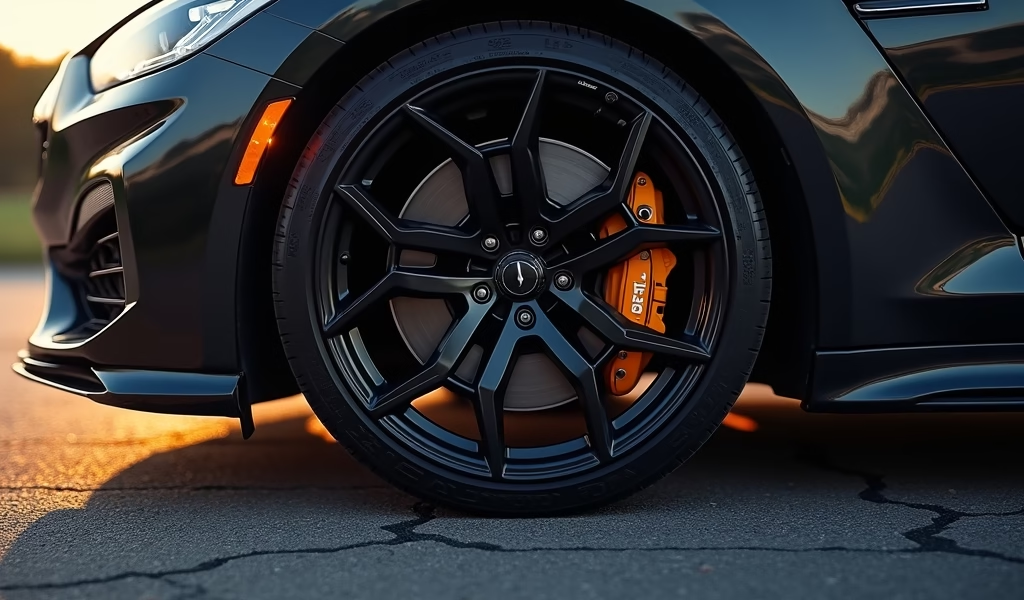Overview
This article explains how forged wheels provide significant performance improvements through weight reduction, detailing five key strategies: understanding wheel weight fundamentals, choosing optimal wheel construction, optimizing design elements, utilizing precision machining techniques, and implementing lightweight finishing components. The physics of reducing unsprung rotational mass creates dramatic handling, acceleration, and braking benefits that many drivers find worth the premium investment of $1,000-$5,000+ per wheel set.
Table of Contents
- Why Wheel Weight Matters
- Step 1: Understanding Wheel Weight Fundamentals
- Step 2: Choose the Right Forged Wheel Construction
- Step 3: Optimize Wheel Design Elements
- Step 4: Precision Machining Techniques
- Step 5: Finishing Touches for Maximum Weight Reduction
- The Bottom Line: Performance Gains vs. Investment
- Conclusion
- Frequently Asked Questions
Ever stared at your car and thought, “You know what? We could go faster if you just lost a little weight”? Well, you’re not alone. As a mechanic who’s spent 20 years helping cars shed their unnecessary pounds, I’ve seen the transformative power of forged wheel weight reduction firsthand. It’s like watching someone switch from work boots to running shoes—suddenly, everything just moves better.
At our shop, we’ve helped countless gearheads transform their driving experience through strategic wheel upgrades. And let me tell you, nothing—and I mean nothing—gives you as much performance bang for your buck as dropping those rotational pounds where it matters most.
But before you dive headfirst into the world of forged wheels, let’s break down exactly how to maximize their weight-saving potential. After all, not all weight reduction is created equal, and your wallet deserves the best return on its investment.
Why Wheel Weight Matters
Remember that time you tried running in heavy winter boots versus your favorite sneakers? That dramatic difference in how nimble you felt? Your car experiences the same sensation when you reduce wheel weight.
The old racing adage that “unsprung weight is worth 10 times its equivalent in sprung weight” isn’t just garage talk—it’s physics. When you reduce weight that isn’t supported by your suspension (like wheels and tires), the performance benefits multiply dramatically.
Forged wheels aren’t just lighter—they’re fundamentally different from cast wheels at a molecular level. While cast wheels are essentially metal poured into a mold like a cake, forged wheels are hammered under massive pressure—up to 9,000 tons in some cases—compressing the metal’s grain structure to create something stronger yet lighter.
It’s like the difference between a fluffy cake and a dense, chewy brownie—one has air pockets everywhere; the other is compressed into something much stronger. This unique manufacturing process creates wheels that can be dramatically thinner without sacrificing strength, giving you that magical combination of reduced weight and increased durability.
But what does this actually mean for your driving experience? In simple terms: quicker acceleration, sharper handling, better braking, and reduced stress on every part of your suspension. When your wheels respond faster, everything else follows suit.

Step 1: Understanding Wheel Weight Fundamentals
Not all weight is created equal when it comes to wheels. There’s a crucial distinction between static weight (what your wheel weighs on a scale) and rotational mass (how that weight is distributed around the wheel’s axis).
Here’s where the magic happens: reducing weight at the outer edge of the wheel (the rim) has a dramatically greater impact than reducing weight near the hub. Why? Because physics says that rotational inertia increases exponentially the further mass is from the center of rotation.
In plain English: a single pound saved at the outer rim might be worth three or four pounds saved near the hub. This is why proper wheel weight balancing matters so much for performance.
When you switch from factory cast wheels to quality forged alternatives, you’re typically looking at weight savings of 5-15 pounds per wheel. That might not sound revolutionary until you remember we’re talking about unsprung, rotational weight—the performance equivalent of putting your car on a serious diet and fitness program simultaneously.
One customer described the feeling perfectly after we installed a set of forged wheels on his BMW M3: “It’s like someone replaced my car’s coffee with espresso—everything just happens faster now.” That’s rotational mass reduction in action!
Step 2: Choose the Right Forged Wheel Construction
When diving into the world of forged wheels, you’ll quickly discover there’s no one-size-fits-all solution. Each manufacturing approach offers different benefits, and choosing the right one for your needs can make all the difference.
Let’s break down your options:
Fully Forged vs. Flow-Formed
Fully forged wheels undergo the complete forging process throughout their entire structure. Think of it as the difference between a hand-carved sculpture and a cast figurine—every molecule has been carefully aligned through pressure. These offer the ultimate strength-to-weight ratio but come with a premium price tag.
Flow-formed (or roll-forged) wheels represent a middle ground. The center is typically cast, while the barrel undergoes a spinning process under heat and pressure that creates similar grain alignment to forging. As one customer put it, “It’s like getting business class when you can’t quite afford first—still a massive upgrade from economy!”
Monoblock vs. Multi-Piece
Monoblock wheels are forged from a single piece of metal, typically resulting in the lightest possible construction. There are no seams, no joints, just one continuous piece of precision-engineered metal.
Multi-piece wheels consist of separately manufactured components (usually a center section and outer rim) joined together. While traditionally heavier, they offer greater flexibility for repairs and customization. Modern multi-piece designs with forged components can approach monoblock weights while offering the convenience of being able to replace just a damaged section rather than the entire wheel.
Material Selection
Most forged wheels use aluminum alloys (typically 6061-T6 or 7075-T6), but some premium options feature magnesium alloys for even greater weight savings. According to research from the Society of Automotive Engineers, magnesium wheels can reduce weight by up to 25% compared to aluminum alternatives.
However, magnesium comes with significant drawbacks: higher cost, increased maintenance requirements, and greater susceptibility to corrosion. For most street applications, high-grade aluminum forged wheels offer the best balance of weight, strength, and practicality.
Remember: the “best” construction method depends on your specific needs. Track-focused drivers might prioritize absolute minimum weight, while someone building a show car might value the customization options of multi-piece designs. The key is understanding what matters most for your particular application.
Step 3: Optimize Wheel Design Elements
Ever wonder why some wheels look like they have more “holes” than metal? There’s science behind those designs, and it’s all about strategic weight placement. When shopping for forged wheels, pay special attention to these design elements that can dramatically impact weight:
Spoke Design and Count
Fewer spokes generally means less material and lower weight, but this must be balanced with structural requirements. Y-spoke and V-spoke designs have become popular for good reason—they effectively distribute loads while minimizing material.
I once had a customer ask, “Why does my wheel need ten spokes when five would be lighter?” The answer came when he took a sharp corner with a pothole—proper spoke design isn’t just about weight; it’s about maintaining structural integrity under real-world stress.
The wheel diameter measurements play a crucial role here too—larger wheels require more structural support to maintain rigidity, often necessitating additional spokes or thicker designs.
Barrel Thickness
This is where forged wheels truly shine. Thanks to their compressed grain structure, forged wheels can safely run barrel walls as thin as 1.8-2.2mm, compared to 3-4mm for typical cast wheels. That difference might seem small on paper, but multiply it around the entire circumference of the wheel, and you’re looking at significant weight savings exactly where it matters most.
Weight-Saving Pockets
Premium forged wheels often feature machined pockets or undercuts in non-structural areas. These aren’t just for show—they’re strategically placed to remove weight without compromising integrity. Look for wheels with complex spoke profiles that have been hollowed out in non-load-bearing areas.
As one wheel designer told me, “We basically play a game of ‘where can we remove metal without making things explode?’ The answer is surprisingly complex.”
Lip Design
The outer lip of the wheel can be a significant contributor to weight. Some designs incorporate stepped or tapered lips that reduce material while maintaining visual impact. Remember—every gram removed from the outer edge yields exponential performance benefits.
When examining wheel designs, ask yourself: “Is this detail functional, or just decorative?” The most effective weight-saving designs make every gram of material earn its place. As with any diet, it’s not just about losing weight—it’s about losing it from the right places.
Step 4: Precision Machining Techniques
Remember when you were a kid and sculpted things from clay? Modern wheel manufacturing is like that, except the “clay” is aerospace-grade aluminum, and the “fingers” are million-dollar CNC machines with micron-level precision. The magic happens when manufacturers apply advanced machining to remove non-essential material:
CNC Machining Magic
Today’s 5-axis CNC machines can create incredibly complex pocket designs that would be impossible with traditional methods. These computer-controlled marvels follow precise digital models to remove material from specific areas of the wheel, often taking multiple passes to achieve the perfect balance of weight and strength.
One wheel manufacturer showed me their machining process, and I was mesmerized watching material disappear like butter under a hot knife, leaving behind only what was structurally necessary. It’s like watching a digital sculptor at work.
Backpad Milling
The backside of the wheel—what mechanics call the “backpad”—is prime real estate for weight reduction. Since it’s not visible when mounted, manufacturers can get aggressive with removing material here. Some premium wheels remove as much as 30% of the backpad material through strategic pocketing.
A wheel engineer once told me, “The backpad is our secret playground. Nobody sees it, but everyone feels the difference it makes.”
Spoke Face Machining
Those beautiful machined details on the face of high-end wheels aren’t just for looks. Complex spoke designs with multiple levels and contours remove significant material while maintaining visual impact. The next time you see a wheel with intricate machining, remember—those details are saving precious grams.
Undercut Technologies
The most advanced wheels utilize undercuts—areas where material is removed from beneath visible surfaces. These hidden weight-saving measures allow wheels to maintain their structural appearance while secretly shedding pounds. It’s like wearing a tailored suit that makes you look substantial while actually being lightweight.
According to comprehensive wheel weight databases, properly machined forged wheels can weigh up to 40% less than their cast counterparts of identical size and design. That’s the power of precision machining in action.

Step 5: Finishing Touches for Maximum Weight Reduction
Ever heard the saying “take care of the pennies, and the pounds take care of themselves”? When it comes to wheel weight reduction, those “pennies” are the small components that, when optimized, add up to significant weight savings:
Lightweight Hardware
Standard lug nuts might weigh 1-2 ounces each. Multiply that by five lugs per wheel, four wheels per car, and suddenly you’re carrying around 2-3 extra pounds of rotating weight! Titanium or aluminum lug nuts can cut that weight by 50-70%.
For multi-piece wheels, consider titanium assembly bolts. They’re not cheap, but they can save several ounces per wheel while actually increasing strength. One racer I know refers to his titanium hardware as “expensive invisible performance” because nobody sees it, but the stopwatch doesn’t lie.
Center Cap Considerations
OEM center caps are often unnecessarily heavy plastic affairs. Switching to lightweight alternatives (carbon fiber is popular) or minimalist designs can save several ounces per wheel. It might seem trivial, but remember—we’re talking about weight at the wheel’s furthest point from the center of rotation.
Balancing Methods
Traditional wheel weights add, well, weight. Consider asking your installer about using balance beads inside the tires instead of stick-on weights. These tiny ceramic spheres distribute themselves naturally as the wheel spins, providing perfect balance without the need for external weights.
Another approach is “match mounting,” where the tire’s lightest point is aligned with the wheel’s heaviest point, minimizing the need for balance weights altogether. It’s a technique borrowed from racing that’s increasingly available at specialty tire shops.
Valve Stem Selection
It sounds ridiculous to worry about valve stems, doesn’t it? But consider this: metal valve stems weigh less than rubber ones, and specialized lightweight racing valve stems can save additional grams. When you’re pursuing maximum performance, no detail is too small.
As one customer laughed after we installed ultra-lightweight valve stem caps, “I’m probably spending about $50 per gram saved at this point, but hey, at least I know I’ve left nothing on the table!” That’s the spirit of true optimization—leaving no stone unturned in the quest for maximum performance.
Checking your wheel rim width compatibility is also crucial before making any changes to ensure your new components will work perfectly with your existing setup.
The Bottom Line: Performance Gains vs. Investment
Let’s get down to brass tacks—what can you actually expect from implementing these weight-saving strategies, and what will it cost you?
By following all five steps, you’re looking at potential weight savings of 10-20+ pounds per corner compared to factory wheels. That’s up to 80 pounds of unsprung, rotating weight eliminated from your vehicle—the equivalent of removing a small child from your suspension system!
The performance benefits are tangible and multifaceted:
- Quicker acceleration (less rotational mass to spin up)
- More responsive steering (reduced gyroscopic effect)
- Shorter stopping distances (less momentum to halt)
- Improved ride quality (suspension responds more quickly to road imperfections)
- Reduced stress on suspension components (less unsprung weight bouncing around)
But—and there’s always a “but”—these benefits come with a financial consideration. Fully optimized forged wheels typically range from $1,000 to $5,000+ per set, depending on size, design complexity, and brand prestige. Is it worth it?
Here’s my honest take after 20 years in the business: wheel upgrades offer one of the best performance-per-dollar returns of any modification. Unlike engine upgrades that might only benefit straight-line speed, or suspension changes that primarily affect cornering, lightweight wheels improve virtually every aspect of vehicle performance simultaneously.
I’ll never forget what one skeptical customer told me six months after installing forged wheels on his daily driver: “I thought you were overselling the difference, but now I get it. It’s like I’m driving a completely different car—everything just feels more precise, more immediate.”
That’s the magic of forged wheel weight reduction—it doesn’t just change one aspect of performance; it enhances the fundamental character of how your car drives. And for many enthusiasts, that holistic improvement is worth every penny.
Conclusion
As we’ve traveled through the world of forged wheel weight reduction, one truth stands out: when it comes to wheels, less truly is more. The weight you eliminate from those spinning circles has a ripple effect through your entire driving experience.
Think of optimizing your wheels as the automotive equivalent of upgrading from work boots to track shoes—suddenly, everything feels more nimble, more responsive, more connected to the road. It’s not just about going faster; it’s about enhancing that crucial connection between driver, car, and asphalt.
Whether you’re chasing tenths on the track or just want your daily commute to feel more engaging, strategic wheel weight reduction through forged technology represents one of the most effective paths to enhanced performance. And unlike many modifications that scream for attention, lightweight wheels do their work quietly—felt rather than heard.
So the next time you’re considering performance upgrades for your vehicle, remember that old racing wisdom: start with the parts that spin. Your car—and that grin spreading across your face in the first corner—will thank you.
Frequently Asked Questions
How much weight can I save by switching to forged wheels?
Typical weight savings range from 5-15 pounds per wheel compared to factory cast wheels. This can total up to 40-60 pounds of unsprung weight reduction for the entire vehicle.
Are forged wheels worth the extra cost over cast wheels?
For performance-oriented drivers, absolutely yes. Forged wheels offer superior strength-to-weight ratio, better durability, and significantly improved handling characteristics that affect every aspect of driving performance.
Will lighter wheels improve my fuel economy?
Yes, though the improvement is typically modest. Lighter wheels reduce rotational mass and rolling resistance, which can improve fuel economy by 1-2% in most cases.
Do forged wheels require special maintenance?
Not typically. Forged wheels actually tend to be more durable than cast wheels, though their high-end finishes might require appropriate care to maintain their appearance.
Can I bend or crack forged wheels?
While forged wheels are significantly stronger than cast wheels, they can still be damaged by severe impacts. The good news is they’re more likely to bend than crack, often allowing for repair rather than replacement.

